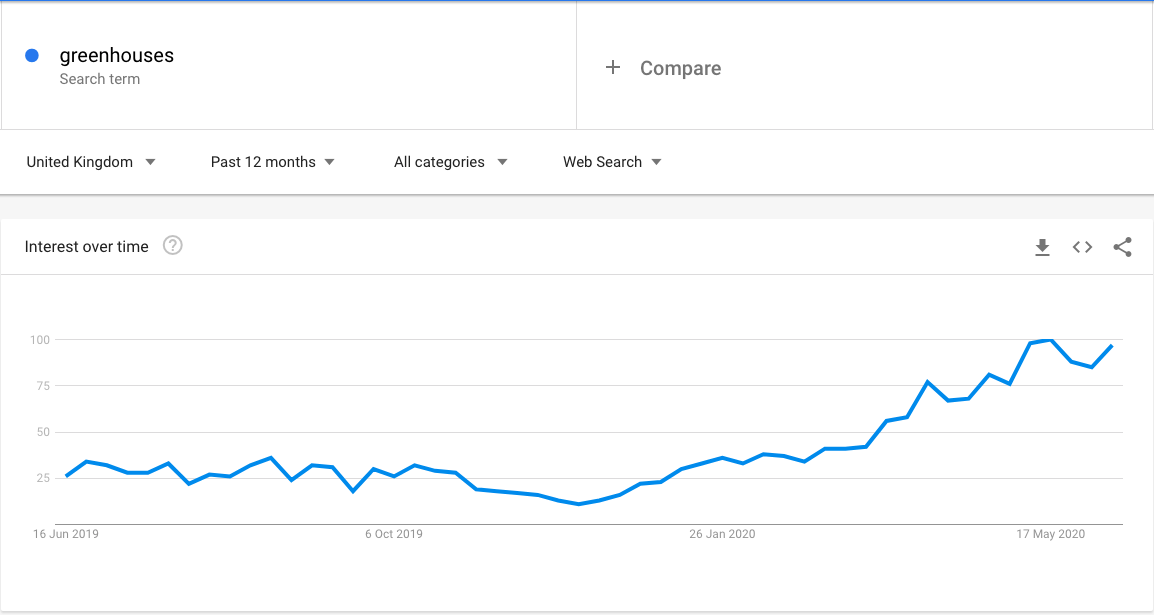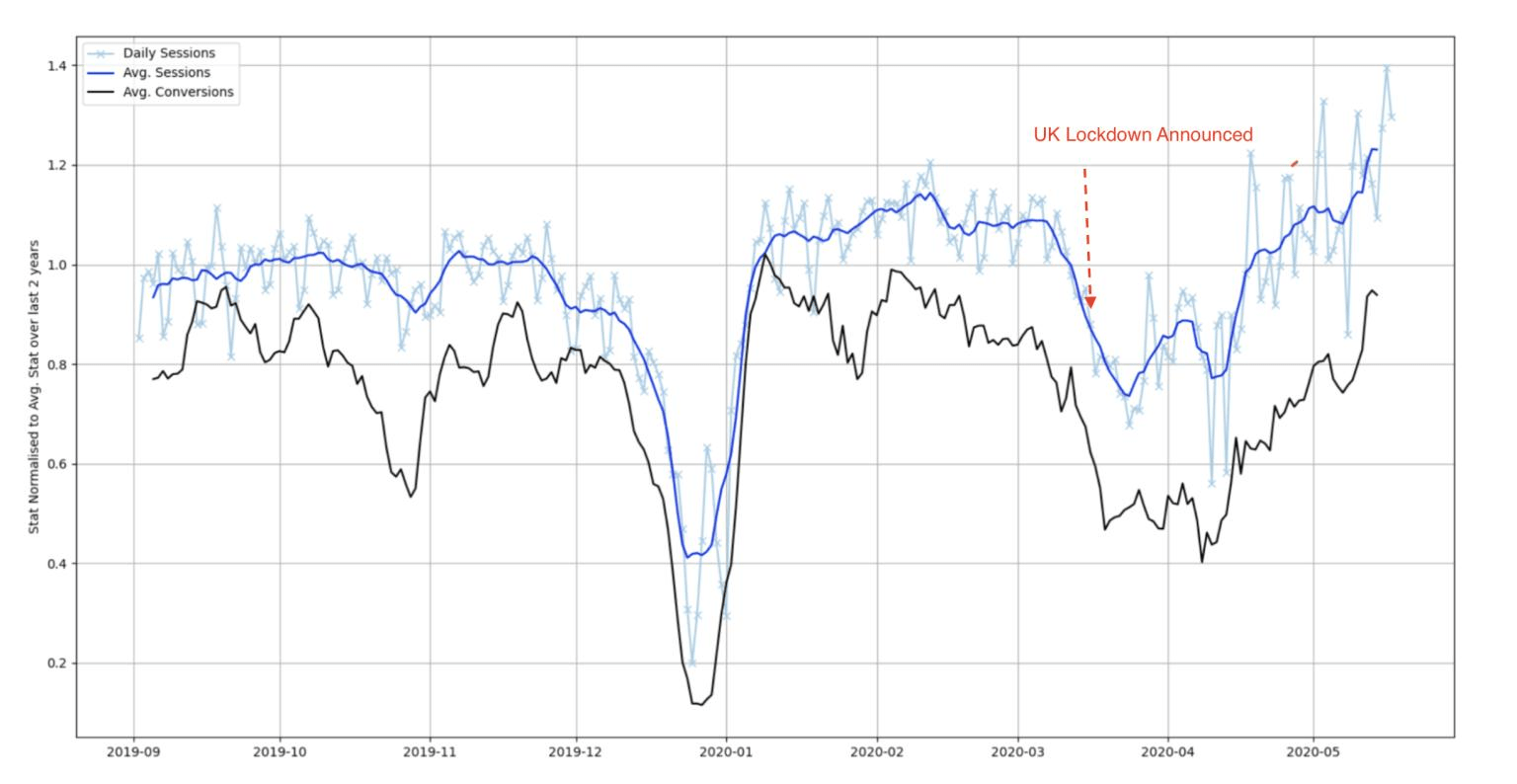Now more than ever, in this world of rapid change and uncertainty, it is important to leverage readily available data to spot opportunities, pivot existing marketing tactics and grow online, even in spite of new obstacles.
Here, I’ll explain how you can utilise data to ensure sustainable recovery and growth during this turbulent period and I will provide insight into what trends Hallam is seeing, not only from data generated from our client base, but also from the data gathered by industry experts, including Google.
How to leverage marketing data to pivot your strategy during times of turbulence
Analysing and interpreting trends in data has always been at the heart of the discussions that we have with our clients. There is an incredible, and often overwhelming, volume of data and insights that you can gather to empower your decision-making.
I recommend you gather data points from three key areas to gain a consumer centric view of how external events like COVID is impacting on your marketing. This will allow you to prioritise the insights most relevant to your business both now and for the future. Your focus can be broad (data to reflect your entire marketing journey) or narrow (data around a specific campaign).
- Readily available consumer behaviour data – understanding actions
- Customer feedback and sentiment data – understanding emotions
- Market trends and insights – understanding impact
Collecting data also shouldn’t be seen as the magic bullet either, it’s what you do with it that counts. Before switching tactics, you should follow this 3 step process.
- Collect the data from available sources
- Analyse the data – ask what is this data telling me?
- Application of the data- develop a new strategy and quickly take action
Focus 1 – Consumer behaviour marketing data
Consumer behaviour has been impacted heavily because of coronavirus. Your customers are likely to be online, now more than ever, it has been reported at the start of lockdown there was a 70% rise in internet usage which makes sense given the closure of many physical stores. As restrictions are lifted it will continue to be important for you to stay in tune with your audiences behavioural shifts online and ensure that your strategies are adapted to meet their new demands.
This applies both to business to business (B2B) and business to consumer (B2C) marketing. Decision makers in businesses are themselves consumers, gathering a deeper understanding of their challenges and new behaviour patterns will enable you to truly provide a valuable and memorable online experience.
Where can you find consumer behaviour data?
Consumer behaviour data can be readily found both from internal (first party data) and external data sources (second and third party data). The best place to start is with your own first party internal marketing data that comes straight from your audience and customers. You know this data is of high quality and it is highly relevant to your business.
Platforms such as Google Analytics, linked directly to your website, can provide a wealth of behavioural data and audience insights. You can also pull data from other internally owned databases such as customer relationship management (CMS) platforms.
Behavioural analytics
The Audience and Behaviour reports section of Google Analytics will provide a wealth of information around your online users, you can drill down into audience demographics, their interests and online behaviour. You can use the reports in the ‘behaviour’ section to answer questions such as:
- Is my audience engaging with the content I’m putting out?
- What actions is my audience taking on my site, has there been a change of behaviour since lockdown?
- Has there been a surge in browsing or purchasing for a particular product?
- Now that lockdown is easing, are my customers changing their online behaviour?
A behavioral analytics example
Looking at Hallam’s own Google Analtyics behavioral data, we spotted an upsurge in visitors during the pandemic to our website in the form of referral traffic from online learning platforms like Coursera and university online courses.

The data is revealing marketing professionals taking advantage of enforced lock down to do professional development, and online universities are signposting learners to the content the Hallam blog in their course references.
We also learned that this is highly engaged traffic, consuming 26% more pages per session on our site than average.
This referral traffic is raising brand awareness of Hallam as a trusted source of marketing information in a way we would not have anticipated under different circumstances than the pandemic. And of course these learners someday could become our customers as they progress through their marketing qualifications journey online.
Based on this data, we pivoted our own marketing strategy to engage directly with course tutors to provide even more helpful information, share the most useful resources for their students. We updated the referenced pages, and are running tests with new calls to action (CTA.) This helpful approach is all part of our COVID marketing strategy.
If you see any large swings in the data, either positively or negatively, try and examine why you think users have changed their behaviour at this time and how you can pivot your messaging or advertising strategy to reflect that change. The more personalised you are, the more effective your marketing will be.
Search data
You should also determine how your target audience’s search behaviour is changing throughout this time. As we are entering a new phase of lockdown we have to deliver compelling content that is informative, supportive and searchable.
Google Search Console and Google Trends are two platforms that provide insight into users’ search behaviour. You can use Google search console to monitor any fluctuations in search queries (what someone typed in before landing on your website) and Google trends to immediately spot potential topics that are on the rise or fall in consumer consciousness.
Hallam has a number of clients who really benefited from utilising this real-time data to preempt a large surge, or fall, in business. One of our clients who sells gardening products, saw a large increase in search volume and demand at the beginning of lockdown specifically for greenhouses. Because of this we anticipated a high growth period and adjusted our digital strategy accordingly, including focusing our effort on developing relevant and searchable content that will drive sales of greenhouses.

Focus 2 – Customer feedback and sentiment data
During the COVID crisis brands have been looking for new ways to adjust to the new normal. Now more than ever it’s important to take the time to listen to your customers and build trust by putting their needs and concerns at the centre of your online activity. As consumers, we are changing how we interact with brands, we want brands to listen and modify their interaction with us with lightning speed. Not only that, brands need to be authentic.
How to collect sentiment data
Customer sentiment can be defined as a positive or negative feeling towards your brand, product, service or the market you operate in. Gathering this data will provide you with an insight into the public opinion of your brand, and how it is changing over time. However, it can be challenging to collect enough quality sentiment data to really be able to make informed decisions about your marketing activity or campaigns.
There are dedicated sentiment analysis tools that can do a lot of the hard work for you and listen in to what your audience is saying about your brand. They typically work by gathering the text data when your brand is mentioned e.g. from a social media post in a way to gather information around intent and tone, and label up this text as either positive, neutral or negative.
Sentiment analysis tools to use
There are a number of sentiment analysis tools to choose from, and at Hallam we have experience supporting our clients with social listening and sentiment analysis using tools such as Sprout Social, Brandwatch and Awario – each with their own strengths and weaknesses. Most of these platforms have a free trial so signing up and seeing if these tools will benefit your business is the way to go.
But what about if you don’t have a well known brand or large social media presence?
The best way to learn more about your customers is by asking them a question. You don’t have to have a large brand presence or social media following to do this, although it certainly helps! You can use survey tools such as SurveyMonkey or Google Surveys.
Focus 3 – Market and industry insights
COVID is impacting every industry in a unquestionably unique way, and as we ease out of lockdown it is important to get a birds eye view of how this pandemic is affecting your sector. Collecting data regarding customer spending habits, geography, industry competitors, and economic conditions will support making smart decisions when it comes to your online activity.
Where to find industry insights and trends data
- ‘Think with Google’ online toolset can help you keep track of industry trends and insights
- Use Feedly to keep on top of industry news and to stay on top of your competition
- Set up Google Alerts to keep track of set topics relating to your market in real-time
- Statista has a wealth of free and paid for industry reports, surveys and statistics
- Media outlets and online publications such as eConsultancy and Gartner and provide dedicated online market trends resources to support business adapt during this time
A story from Hallam customer data – the road to recovery
At Hallam we are seeing a broadly positive story of ‘bounce back’ following the loosening of lockdown across the UK and Europe.
The graph below shows anonymised, aggregated data across all of our 70 clients, that tracks daily web sessions, average web sessions and average web conversions. The data is aggregated to ensure transparency of the results we generate.

This group data is a useful indicator of overall performance, but also of returning market confidence. As you can see, when the lockdown was fully implemented, we saw a 33% reduction in traffic and a 50% drop in conversions.
We are pleased to say that, broadly, there has been a strong recovery, and performance is now 10% higher than pre-lock down levels.
Do you want Team Hallam on your side?
Get in touch to arrange an informal chat and learn how our experts can help your business to thrive online.








